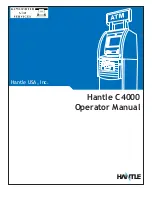
UltraLo-1800 Alpha Particle Counter
XIA LLC
Page 41
3.
Diagnostic Panel
The Diagnostic panel is the final of the three primary panels. It is mostly used for debugging or
checking for changes in the noise environment. It cannot be launched during a measurement or when
the hardware is not connected. It is launched from the Tools menu on the Main Panel.
a)
Trigger Thresholds
Trigger thresholds on the Anode/Guard. These come pre-set from XIA. Unless the UltraLo-1800’s
noise environment changes rather dramatically they should never need changing. If the thresholds are
set too low (around 100-125) the electronics will trigger on detector noise, and if they’re too high low-
energy alphas might not be detected. Experimentation at XIA has found that 175 on the Anode strikes a
good balance. The units are arbitrary, but the choice of 175 corresponds to a cutoff of about 1.5 MeV,
with higher thresholds cutting off at higher energies, and lower threshold cutting off at lower energies.
Typically the guard is set to 0, meaning triggers on the guard alone will not cause the system to trigger.
Since guard-only events cannot be sample alphas, it’s not necessary to record them.
b)
Oscilloscope Plot
The Oscilloscope plot displays 8000 raw ADC values of a selected channel collected at a chosen
sampling interval. To select a sampling interval, enter a time into the Time Step box (b
1
). The valid range
of time steps is from 0.125 µs to 400 µs, so a time step of 400 µs has a total duration of 3.2 seconds.
Different time steps will emphasize different frequency ranges. To select a channel use the Channel (b
2
)
Figure VI-9: Diagnostic Panel with Anode trace and FFT displayed. The letters indicate the letter of the headings below, which are: a) Trigger
Thresholds; b) Oscilloscope Plot; b
1-3
) Parameters associated with Oscilloscope Plot; c) Statistics Box; d) FFT Plot.














































